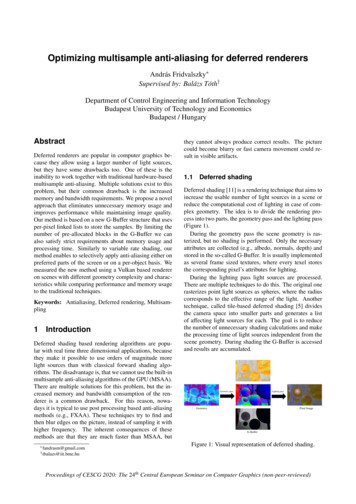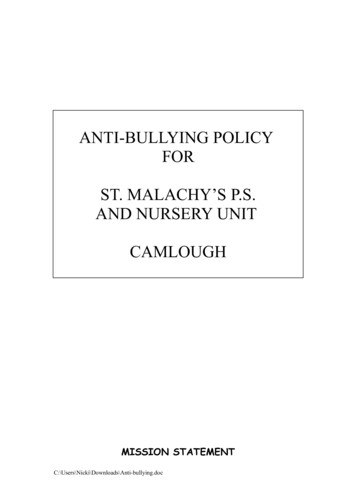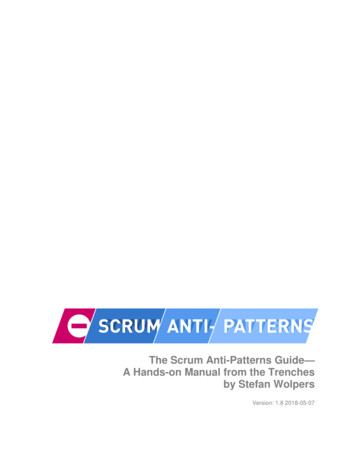
Transcription
Optimizing multisample anti-aliasing for deferred renderersAndrás Fridvalszky Supervised by: Balázs Tóth†Department of Control Engineering and Information TechnologyBudapest University of Technology and EconomicsBudapest / HungaryAbstractDeferred renderers are popular in computer graphics because they allow using a larger number of light sources,but they have some drawbacks too. One of these is theinability to work together with traditional hardware-basedmultisample anti-aliasing. Multiple solutions exist to thisproblem, but their common drawback is the increasedmemory and bandwidth requirements. We propose a novelapproach that eliminates unnecessary memory usage andimproves performance while maintaining image quality.Our method is based on a new G-Buffer structure that usesper-pixel linked lists to store the samples. By limiting thenumber of pre-allocated blocks in the G-Buffer we canalso satisfy strict requirements about memory usage andprocessing time. Similarly to variable rate shading, ourmethod enables to selectively apply anti-aliasing either onpreferred parts of the screen or on a per-object basis. Wemeasured the new method using a Vulkan based rendereron scenes with different geometry complexity and characteristics while comparing performance and memory usageto the traditional techniques.Keywords: Antialiasing, Deferred rendering, Multisampling1 IntroductionDeferred shading based rendering algorithms are popular with real time three dimensional applications, becausethey make it possible to use orders of magnitude morelight sources than with classical forward shading algorithms. The disadvantage is, that we cannot use the built-inmultisample anti-aliasing algorithms of the GPU (MSAA).There are multiple solutions for this problem, but the increased memory and bandwidth consumption of the renderer is a common drawback. For this reason, nowadays it is typical to use post processing based anti-aliasingmethods (e.g., FXAA). These techniques try to find andthen blur edges on the picture, instead of sampling it withhigher frequency. The inherent consequences of thesemethods are that they are much faster than MSAA, but fandrasm@gmail.comthey cannot always produce correct results. The picturecould become blurry or fast camera movement could result in visible artifacts.1.1Deferred shadingDeferred shading [11] is a rendering technique that aims toincrease the usable number of light sources in a scene orreduce the computational cost of lighting in case of complex geometry. The idea is to divide the rendering process into two parts, the geometry pass and the lighting pass(Figure 1).During the geometry pass the scene geometry is rasterized, but no shading is performed. Only the necessaryattributes are collected (e.g., albedo, normals, depth) andstored in the so-called G-Buffer. It is usually implementedas several frame sized textures, where every texel storesthe corresponding pixel’s attributes for lighting.During the lighting pass light sources are processed.There are multiple techniques to do this. The original onerasterizes point light sources as spheres, where the radiuscorresponds to the effective range of the light. Anothertechnique, called tile-based deferred shading [5] dividesthe camera space into smaller parts and generates a listof affecting light sources for each. The goal is to reducethe number of unnecessary shading calculations and makethe processing time of light sources independent from thescene geometry. During shading the G-Buffer is accessedand results are accumulated.Geometry passLighting passGeometryFinal ImageG-BufferFigure 1: Visual representation of deferred shading.† tbalazs@iit.bme.huProceedings of CESCG 2020: The 24th Central European Seminar on Computer Graphics (non-peer-reviewed)
1.2Multisample anti-aliasingAliasing is a common problem during rendering. For example when we rasterize the scene geometry, the samplingrate is too low and geometry aliasing occurs. The visible results are the jagged edges in the final picture. Tosolve this, we apply anti-aliasing methods in our renderingpipelines (Figure 2). One method is supersampling whichrenders the scene in a higher resolution than the target’s,then downsamples it. This solution targets the root cause,the undersampling of frequencies, but it comes with highperformance costs.Figure 2: Results of anti-aliasing. From left to right: NOAA, FXAA, 8x MSAA, the Proposed Algorithm.Multisample anti-aliasing (MSAA [9]) is a hardware accelerated optimization of supersampling. It aims to reducethe number of shading calculations by only doing supersampling where it is necessary. These parts are the edgesof the rasterized triangles, where large differences can occur in the final colour. With MSAA we still store multiplesamples per pixel (just like with supersampling), but shading is only performed for some of them. Where the rasterizer detects that a triangle covers some sample in a pixel itinvokes the fragment shader only once, but the result willbe written to each covered sample. After that, samples areaveraged to compute the final colour of the pixel.1.3Deferred shading with MSAAWhen multisampling is applied to a deferred renderer wecan no longer use the basic hardware accelerated process.The whole G-Buffer must be created with higher samplingfrequency (using MSAA). The information about pixelcoverage must be stored in the G-Buffer too. Increasedsize can already become a problem for mobile devices, butthe memory bandwidth consumption makes it very taxingon desktop GPUs too. A further problem is that during thelighting pass we do not want to calculate shading for duplicated sample data. A complex logic to select the uniquesamples for shading is unpractical for the massively parallel nature of the GPU, but if we settle with less accurateselections (e.g., simple, and supersampled pixel) then itwill result in many unnecessary calculations.In this work we analyse the previously mentionedproblems with the combination of deferred shading andMSAA. We introduce a new method to mitigate these andimplement it in a modern renderer with Vulkan and C .2 Related workTo apply anti-aliasing Reshetov [10] proposed a postprocessing based approach, which worked by searchingvarious patterns in the final image and blending the coloursin the neighbourhood. It can be used efficiently in a deferred renderer. Lottes et. al [7] proposed a different implementation based on the same idea with alternative edgedetection mechanism. Jimenez et. al [4] adapted the original technique to work together with traditional MSAA andtemporal supersampling to recover subpixel features.Chajdas et. al [2] proposed a method that used singlepixel shading with sub-pixel visibility to create antialiased images.Another branch of the anti-aliasing techniques uses previous frames to solve the problem. A recent variant, proposed by Marrs et. al [8] combines it with supersamplingand raytracing.Liktor et. al [6] proposed an alternative structure forthe G-Buffer which allows efficient storage of sample attributes. They used this structure for stochastic renderingand also for anti-aliasing.Salvi et. al [12] proposed a method for deferred renderers that reduces the stored and shaded sample count bymerging samples that belong to the same surface. Crassinet. al [3] proposed a similar method that uses more complex criteria to group samples together and calculate aggregate values. Both methods are using a pre-pass beforefilling the G-Buffer to generate supporting information forsubsequent passes.Our implementation of the G-Buffer uses a structuresimilar to the A-buffer, proposed by Carpenter et. al [1].The A-Buffer can be used for order independent transparency by collecting and sorting every rasterized fragment for each pixel in linked lists. Instead, we collectonly the visible samples for every pixel and skip the sorting step.3 The proposed algorithmThe main problem of multisampling in case of deferredshading is the redundant storage of samples. The standard G-Buffers are using textures to store per-pixel data.In case of multisampling we need to use larger texturesto store more samples. By using 8x multisampling we effectively use eight times more memory. Most of it is unnecessary because a large part of the screen requires only1-2 samples. This redundancy also causes further problems. MSAA is faster than supersampling, because onlyone sample is shaded for each fragment that is covered byProceedings of CESCG 2020: The 24th Central European Seminar on Computer Graphics (non-peer-reviewed)
just one triangle. It is a great optimization for forward renderers, but during the lighting pass of a deferred rendererthis information is not available. It means we must recoverit manually or use supersampling, effectively losing all thebenefits of MSAA.The proposed technique consists of an alternative datastructure for the G-Buffer and algorithms to build and useit. The G-Buffer is divided into two parts. The first onecontains one block of data for each pixel. It representsthe basic G-Buffer used in standard deferred shading. Italso contains the heads of per-pixel linked lists that storedata for the rest of the samples, originating from the samepixel. These linked lists are stored in the second part ofthe G-Buffer. The whole structure can be represented onthe GPU as a Shader storage buffer object (SSBO).The idea is that we construct the G-Buffer in a wayto prevent redundancy. Then during the lighting pass weknow for certain that every block of data must be shadedand no unnecessary calculations will be done. The required size for the G-Buffer is reduced too.To construct the G-Buffer scene geometry is rasterizednormally using the maximum desired multisampling frequency. The target framebuffer contains only a depthbuffer with the appropriate sampling rate. Accordingto the behaviour of standard multisampling the fragmentshader is invoked for every triangle-pixel intersection andeach invocation represents one or more samples. The attributes for lighting calculation are collected. The coveredsamples are checked if they contain a previously specifiedindex. If that is the case then the collected data is written into the first part of the G-Buffer. Otherwise, a newblock is allocated from the second part by using an atomiccounter. The block is connected to the pixel’s linked listwith an atomic operation and the data is written into it.This way the G-Buffer becomes free of redundancy exceptfor one case. That is when hidden objects are rasterizedbefore the visible ones. We solve this by running a depthonly Z-prepass before the geometry pass.During the lighting-pass the shading can be done bytraversing the linked lists or the G-Buffer itself in an unordered manner, according to the implementation of thelight sources. In our implementation we did the former.The light sources were stored in a buffer and for everysample we accumulated the shading for every light source.Then the results were averaged, weighted by the numberof covered samples. This implementation of light sourcesis hardly optimal because every light source influences every part of the screen, even where its effect is unnoticeable.We chose this method because it is straightforward to implement and we can reason better about the performancecharacteristics of different number of light sources. It isalso easy to extend to tile-based deferred shading, a popular variant of standard deferred shading.4 ImplementationAfter an overview of the proposed technique, we highlightthe important details of our implementations.4.1The G-BufferIn our shading model we needed the following attributes:albedo, normal, roughness, metallic, ambient occlusionfactor (ao). We also needed a pointer to construct thelinked list.1. bit8.16.24.albedo1 (RGB)albedo2 (RGB)32. ness2ao1ao2pointer1pointer2Figure 3: Structure of two interleaved block in the GBuffer referring to two samples. Every sample uses 112bits.We interleaved every two block of data to prevent anyunnecessary padding (Figure 3). It is another added flexibility of our data structure. The traditional texture basedG-Buffer does not allow this. (It would require 16 bitspadding for every sample.)1. bit26.index1. bit32.next pointerpre-allocated blocks29.sample count32. bitsample indexdynamic blocksFigure 4: Structure of the pointer and the G-Buffer.As depicted in the top of Figure 4, the pointer consistsof three parts. The first 26 bit stores the index of the nextblock in the linked list. Then 3 bits are needed to store thenumber of samples covered by the next block, and another3 bits to store the index of one of these samples. The latteris needed to read the correct value from the multisampleddepth buffer.The final structure of the G-Buffer is shown at the bottom of Figure 4. The number of pre-allocated blocks mustmatch the number of pixels, because even without antialiasing, one sample is needed. (This is the previouslymentioned first part of the G-Buffer.) The number of dynamic blocks depends on the available memory, performance constraints and required quality. Additional samples after the first one are stored here in linked lists.4.2Light sourcesWe only used point light sources in our implementation.As a simplification we also implemented it as a uniformbuffer and every fragment shader invocation iterated overProceedings of CESCG 2020: The 24th Central European Seminar on Computer Graphics (non-peer-reviewed)
the entire list. This does not impact the performance comparisons, because a smarter light source implementationwould affect each measured algorithm in the same way.4.3Z-prepassA simple Z-prepass will not solve the problem of multiplefragment shader invocations for the same sample in thegeometry pass, which can happen when triangles are intersecting with each other. At the intersection, fragmentsfrom different triangles can have the same depth value.This means that both fragments will allocate memory forthe same sample location and it is possible that the resulting linked list will contain more fragments then the number of samples. This conflicts with the average calculationand causes visual errors. A solution for this is to use onebit of the stencil buffer to flag the sample after one invocation and discard subsequent ones.4.4Shadows and transparent materialsIn our implementation we chose to not implement shadows or transparency. Transparency is a common problemfor deferred renderers and they are generally handled separately. Shadow calculation is working well with deferredrenderers. The most popular solutions are shadow mapping and its variations. Our approach does not interferewith these methods and they can be applied to the resolvedimage without changes.5 G-Buffer OptimizationsOur method stores samples in the G-Buffer precisely,when we decide to shade them. This characteristic allowsus to further reduce memory usage by storing fewer samples for certain pixels in the geometry pass. To apply arbitrary maximum sample count for a pixel, we would require another 32 bit atomic counter for every one of them.It is also impossible to ensure deterministic behaviour, sosmall flickering can ruin the results. Instead, we opted touse a maximum of 1 sample. This needs no further memory storage or complexity because we just need to discardevery sample except the one, which goes to the first part ofthe G-Buffer. The remaining question is how to decide ifa pixel only needs one sample. We provide four differentmethods, which can be used either exclusively or simultaneously.5.1detail. The only limitation is the allowed complexity forselecting parts of the screen.Filtering based on locationWe can select certain areas on the screen in advance todisable anti-aliasing by limiting the maximum number ofsamples to one. It goes well with certain kind of programs,where a large part of the screen would get blurred (e.g.,car racing) or with VR where edges of the screen need lessFigure 5: Visualization of sample usage after filtering byan ellipse (black - 1 sample, red - 8 samples).We implemented two methods based on an ellipse (Figure 5) and a rectangle. The latter is given with top, bottom,left and right values while the former with its centre, widthand height. Outside of the selected region, only one sample is stored and no anti-aliasing is performed, while inthe inside everything remains the same as before (dynamicsample count).The advantage is that we know beforehand how manypixels are going to be filtered. We can reason about thememory requirements better and we can reduce it preemptively. The disadvantage is that no dynamic adjustments are done and edges of the selection are clearly visible if a complex, unblurred object intersects it.5.2Filtering based on depthWe can also use the depth buffer to specify a thresholdfor anti-aliasing (Figure 6). It is great for certain scenes,where background objects are always getting blurred orbarely visible (e.g., fog). The problem is, that we mustalso select these objects precisely and reliably based onlyon depth. It helps that we can apply per-frame thresholdsbased on previous frames or by using some other heuristics.5.3Filtering based on objectsSometimes there are objects with very simple geometry (orsome other special properties) that need no anti-aliasing(e.g., spheres).These can be flagged beforehand and excluded from using multiple samples (Figure 6). It is a very specific solution which must be used with care but can boost performance immensely in certain environments while maintaining image quality.5.4Filtering based on edgesA common problem with MSAA is that it applies to everytriangle edge, even when they come from the same objectProceedings of CESCG 2020: The 24th Central European Seminar on Computer Graphics (non-peer-reviewed)
With multiple renderpasses and with a more robust edgedetection algorithm, better results could be achieved, butit could also hinder the performance on mobile devices.6 EvaluationWe benchmarked the performance characteristics of ourimplementation on multiple GPUs (Nvidia GTX970 andGTX1050). We compared the processing time and memory usage to an implementation without anti-aliasing, to aversion of FXAA and to the traditional implementation ofMSAA.Figure 6: Top: Visualization of sample usage after filteringby a depth threshold. The cathedral and the rearmost treeis partially excluded from anti-aliasing. Bottom: Visualization of sample usage after filtering out a pair of trees.and no anti-aliasing would be needed. To reduce thesefalse-positive cases we can use edge detection on the depthbuffer after the Z-prepass to flag true edges on the screen(Figure 7). These can be used to further constrain the antialiasing.The problem with this approach is that by only usingsubpasses we can access the depth only for the currentlyprocessed pixel. This makes it difficult to use robust edgedetection algorithms that would make use of the neighbouring pixels and directional information. We decidedto calculate the minimum and maximum depth values foreach pixel (from the samples) and threshold the difference.Results were not satisfactory, because many true edgeswere excluded.Figure 8: Test scenes used during evaluation, and visualized sample usage.We used three test scenes with various geometry complexity for our measurements. These scenes contain1.424.145, 8.699.022 and 23.820.168 vertices respectively(top row of Figure 8). The number of samples used foreach scene is also shown on the bottom row of Figure 8.First we measured the required memory for 1920x1080resolution (Table 1). Our proposed method has flexiblememory requirements so only minimum and maximumvalues are given. In the case of minimum values no antialiasing will be performed. The actual memory requirements for full anti-aliasing depend on the scene geometry(Figure 3Proposed algorithm4x8xMaxMinMax110.74 27.69 221.4831.64 63.28 63.28142.38 90.97 284.76Table 1: Memory consumption of the anti-aliasing methods in Mbytes.Figure 7: Visualization of sample usage after edge detection on the depth buffer.We also measured the processing times of the antialiasing algorithms. As we can see in Table 2, our algorithm performs well in environments where a large numberof shading calculations must be performed.Proceedings of CESCG 2020: The 24th Central European Seminar on Computer Graphics (non-peer-reviewed)
7 ConclusionFigure 9: Complex scene for memory requirements. Itneeds 115.31 MB memory for 8x and 75.01 MB for 4xanti-aliasing. In the 8x case it is even smaller than thememory requirements of the traditional 4x MSAA implementation.1. scene1. scene2. scene2. scene3. scene3. scene5 light sources50 light sources5 light sources50 light sources5 light sources50 light Proposed 0216.510418.917219.135421.344631.703838.6841Table 2: Computation times of the anti-aliasing methodswithout any G-Buffer optimization (ms).On small scenes with many light sources our techniqueis able to deliver better anti-aliasing results and even better performance than previous solutions. It reacts wellto larger anti-aliasing settings too (left of Figure 10), because it effectively reduces unnecessary shading operations. Complex geometry can present a problem, becauseof the Z-prepass, but only in extreme cases and even then,with equally large number of light sources it still outperforms the traditional method (right of Figure 10).3. Scene - 50 Light Sources3. 50Anti-aliasing settingNumber of light sourcesProposedMSAA 4xProposed 4xMSAAMSAA 8xProposed 8xFigure 10: Relative processing times of the algorithmswith different anti-aliasing settings (left) and number oflight sources (right). The measured values represent therelative performance of the techniques, compared to theimplemantation without anti-aliasing.The proposed algorithm can apply multisample antialiasing in a deferred renderer without unnecessary memory allocations and complex shading logic of traditionalmethods. The performance is better for small scenes whileit also reacts well to more light sources and higher samplecount than the traditional method. The flexible data structure of the G-Buffer prevents any redundancy and enablesto further reduce the allocated storage by selectively applying anti-aliasing. These characteristics permit us to aggressively limit the G-Buffers size and consequently satisfy strict requirements about performance and memoryconsumption.8 AcknowledgementsThis work has been supported by OTKA K-124124, andby the EFOP-3.6.2-16-2017-00013.References[1] Loren Carpenter. The a-buffer, an antialiased hidden surface method. In Proceedings of the 11th annual conference on Computer graphics and interactive techniques, pages 103–108, 1984.[2] Matthäus G Chajdas, Morgan McGuire, and David PLuebke. Subpixel reconstruction antialiasing for deferred shading. In SI3D, pages 15–22. Citeseer,2011.[3] Cyril Crassin, Morgan McGuire, Kayvon Fatahalian,and Aaron Lefohn. Aggregate g-buffer anti-aliasing.In Proceedings of the 19th Symposium on Interactive3D Graphics and Games, pages 109–119, 2015.[4] Jorge Jimenez, Jose I Echevarria, Tiago Sousa, andDiego Gutierrez. Smaa: enhanced subpixel morphological antialiasing. In Computer Graphics Forum,volume 31, pages 355–364. Wiley Online Library,2012.[5] Aaron Lefohn, Mike Houston, Johan Andersson, UlfAssarsson, Cass Everitt, Kayvon Fatahalian, Tim Foley, Justin Hensley, Paul Lalonde, and David Luebke. Beyond programmable shading (parts i and ii).In ACM SIGGRAPH 2009 Courses, page 7. ACM,2009.[6] Gábor Liktor and Carsten Dachsbacher. Decoupleddeferred shading for hardware rasterization. In Proceedings of the ACM SIGGRAPH Symposium on Interactive 3D Graphics and Games, pages 143–150.ACM, 2012.[7] Timothy Lottes. Fxaa. White paper, Nvidia, Febuary,2009.Proceedings of CESCG 2020: The 24th Central European Seminar on Computer Graphics (non-peer-reviewed)
[8] Adam Marrs, Josef Spjut, Holger Gruen, RahulSathe, and Morgan McGuire. Adaptive temporal antialiasing. In Proceedings of the Conference on HighPerformance Graphics, page 1. ACM, 2018.[9] James Peterson, Robert Mullis, and Gregory Hunter.Multi-sample method and system for rendering antialiased images, October 3 2002. US Patent App.09/823,935.[10] Alexander Reshetov. Morphological antialiasing. InProceedings of the Conference on High PerformanceGraphics 2009, pages 109–116. ACM, 2009.[11] Takafumi Saito and Tokiichiro Takahashi. Comprehensible rendering of 3-d shapes. In ACM SIGGRAPH Computer Graphics, volume 24, pages 197–206. ACM, 1990.[12] Marco Salvi and Kiril Vidimče. Surface based antialiasing. In Proceedings of the ACM SIGGRAPHSymposium on Interactive 3D Graphics and Games,pages 159–164, 2012.Proceedings of CESCG 2020: The 24th Central European Seminar on Computer Graphics (non-peer-reviewed)
Keywords: Antialiasing, Deferred rendering, Multisam-pling 1 Introduction Deferred shading based rendering algorithms are popu-lar with real time three dimensional applications, because they make it possible to use orders of magnitude more light sources than with classical forward shading algo-rithms. Thedisadvantageis,thatwecannotusethebuilt-in










